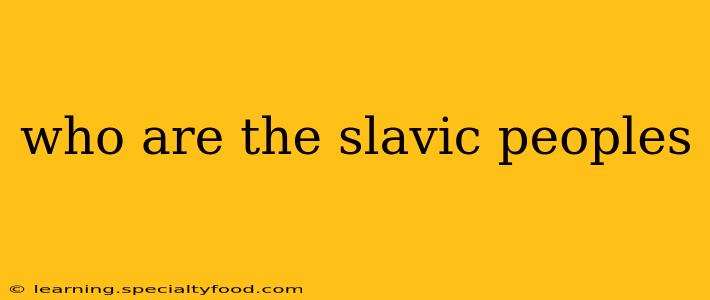The Slavic peoples represent a large group of ethnolinguistic groups inhabiting a vast territory across Eastern Europe, Central Europe, and parts of Northern Asia. Understanding their history and cultural diversity requires looking beyond simple geographical boundaries and delving into a rich tapestry of shared heritage and distinct identities.
What Makes Someone Slavic?
The primary unifying factor among Slavic peoples is language. Slavic languages belong to the Indo-European language family, specifically the Balto-Slavic branch, and are further divided into three main groups: East Slavic, West Slavic, and South Slavic. This linguistic connection forms the bedrock of Slavic identity, though it's important to note significant variations within each group.
Beyond language, shared historical experiences, cultural practices, and religious traditions (primarily Orthodox Christianity, Catholicism, and some indigenous beliefs) have contributed to a sense of Slavic unity, albeit a complex and sometimes contested one. However, it's crucial to emphasize that "Slavic" isn't a monolithic identity. Each individual Slavic group possesses unique cultural features, traditions, and historical narratives.
The Three Main Branches of Slavic Peoples: A Brief Overview
East Slavic Peoples
This branch primarily includes:
- Russians: The largest Slavic group, inhabiting Russia and significant diaspora communities globally.
- Ukrainians: Predominantly residing in Ukraine, with sizable populations in neighboring countries.
- Belarusians: Primarily located in Belarus, with a distinct cultural and linguistic identity.
These groups share a common historical root in Kyivan Rus', but have evolved distinct national identities, languages, and cultural practices over the centuries.
West Slavic Peoples
This branch encompasses:
- Poles: Inhabiting Poland, with significant diaspora communities.
- Czechs: Predominantly residing in the Czech Republic.
- Slovaks: Primarily located in Slovakia.
- Sorbs/Lusatians: A smaller group inhabiting parts of eastern Germany, representing one of the few remaining West Slavic groups outside of the core territories.
Despite shared linguistic roots, these groups developed separate national identities and cultural traditions influenced by their historical contexts and geographical locations.
South Slavic Peoples
This branch includes:
- Serbs: Primarily inhabiting Serbia, with significant populations in other Balkan countries.
- Croats: Predominantly residing in Croatia.
- Bosniaks: Primarily residing in Bosnia and Herzegovina.
- Montenegrins: Residing primarily in Montenegro.
- Slovenes: Inhabiting Slovenia.
- Macedonians: Predominantly located in North Macedonia.
- Bulgarians: Primarily inhabiting Bulgaria.
This branch exhibits remarkable linguistic and cultural diversity, shaped by centuries of interaction with various empires and cultures in the Balkans.
What are the main differences between the Slavic groups?
The differences between Slavic groups are numerous and complex, stemming from centuries of independent development. These differences manifest in various aspects:
- Language: While mutually intelligible to varying degrees within each branch, significant differences exist between East, West, and South Slavic languages, making communication challenging across branches.
- Religion: While Orthodox Christianity dominates in the East, Catholicism is prevalent in the West, and a mix of Orthodox, Catholic, and Islam is present in the South.
- Culture: Traditions, customs, cuisine, and art vary significantly across different Slavic groups, reflecting their unique historical experiences and geographical environments.
- History: The historical trajectories of each Slavic group differ significantly, shaped by interactions with different empires and power structures. These distinct historical experiences significantly impact their national identities and self-perceptions.
Are there any other Slavic groups?
While the three main branches mentioned above are the most widely recognized, there are smaller groups and sub-groups within each branch, as well as ongoing debates about the precise classification of certain groups. The complex historical interactions and the evolution of national identities make defining the boundaries of Slavic groups an ongoing scholarly discussion.
Conclusion: The Complex Tapestry of Slavic Identity
The Slavic peoples represent a diverse and fascinating collection of ethnolinguistic groups. Their shared linguistic roots and some overlapping cultural aspects create a sense of connection, but significant differences exist in language, religion, culture, and history. Understanding the Slavic world requires appreciating both the unifying threads and the rich tapestry of individual identities that make up this vast and influential group of people.
